Scottish Biodiversity Strategy: report to Parliament 2017 to 2019
The fifth report detailing progress on the implementation of the Scottish Biodiversity Strategy, covering the period 2017 to 2019, as required under the Nature Conservation (Scotland) Act 2004.
4. Outcome 2: Natural Capital
Natural resources contribute to stronger sustainable economic growth in Scotland, and we increase our natural capital to pass on to the next generation.
Key steps
- Encourage wider acceptance and use of the Natural Capital Asset Index (2012) including comparable measures for the marine environment
- Use this index to influence decision-making and market-based approaches, so that wider monetary and non-monetary values for ecosystem services are recognised and accounted for
- Undertake a major new programme of conservation, management and restoration (described in Section 3: Outcome 1 Healthy Ecosystems)
There is a clear recognition in Scotland that natural capital contributes to economic growth, and investment in natural capital is identified as a priority in Scotland's Economic Strategy[62]. The natural environment is one of Scotland's greatest assets. It attracts businesses and individuals to live and work in Scotland. The SNH Valuing our environment report[63] reveals the economic value of the environment. Its sustainable use supports 11% of Scotland's total economic output – worth £17.2 billion a year and one in seven full-time jobs. A recent natural capital assessment found that the partial value of Scotland's natural capital was worth £107 billion[64].
4.1 The Natural Capital Asset Index
The Scottish Natural Capital Asset Index[65] (NCAI) was developed by Scottish Natural Heritage to provide a robust and consistent framework for monitoring changes in Scotland's natural capital, helping us to make better-informed decisions, based on an awareness of the relationship between nature, human well-being and economic activity. The National Performance Framework (NPF) includes 55 Scottish Government National Indicators that together provide a mechanism for monitoring progress across all government. The NCAI now constitutes one of the Economy indicators in the NPF as the National Indicator of natural capital[66].
When the NCAI was launched in 2011, Scotland became the first country in the world to publish such a detailed attempt to monitor annual changes in natural capital. The NCAI was reviewed by experts in 2014, and has been subsequently revised. The method was published as a peer-reviewed paper in 2019[67]. It continues to be updated to further refine its methodology and improve the data on which it is based.
4.2 Business and biodiversity
The Central Scotland Green Network (CSGN) undertook research in late 2015 with over 300 senior business decision-makers in central Scotland[68]. Over six in ten businesses that responded indicated that Scotland's natural capital was important to them and should be protected and enhanced. Over 70% considered that action to protect and enhance natural capital was urgent or extremely urgent. These findings correlate with the earlier Scottish Natural Capital Survey[69] conducted by the Scottish Forum for Natural Capital in 2014.
4.3 Natural Capital Accounting
SNH has tested a Natural Capital Accounting[70] approach on land that it owns or substantially manages, mainly as National Nature Reserves. Where possible monetary values were attributed to benefits from nature. SNH also worked with The Crown Estate and other organisations to trial the use of the Natural Capital Protocol for land-based businesses[71].The trial identified reliance, impacts, risks and opportunities of these businesses on natural capital. Further trials are ongoing.
4.4 Assessing progress towards this outcome
The National Capital Asset Index (NCAI) monitors the quality and quantity of terrestrial habitats in Scotland, according to their potential to deliver ecosystem services now and into the future. It is a composite index, using a wide range of measures. The overall stock of natural capital in 2018 has had small improvements since the Index began in 2000 as shown in Diagram 2.
A back-casting exercise was carried out to create a more rudimental version of the NCAI back to 1950. The exercise highlighted that Scotland's natural capital was in long-term decline until the early 1990s, with the extent and condition of most habitats deteriorating, especially peatlands and grassland. Since 2000, the delivery of provisioning services –direct products such as food, fuel and water - has stabilised or slightly improved. The capacity to provide other ecosystem services, including cultural services (such as recreation, education, art, and sense of place) and regulation and maintenance services (such as air filtration or flood protection) has also increased, albeit at a slower pace.
Inland surface water delivers a wide range of ecosystem services, including drinking water, flood management and recreation. The recovery of this habitat is a major contributor to the positive trends in Scotland's natural capital. Woodland also provides a variety of services, and the area of woodland has increased since 2000. It is this, rather than improvements in condition, which has driven improvements in woodland natural capital stocks. However, deterioration in the condition of uplands (including peatlands and heathland) has partially offset these improvements, especially with respect to regulation and maintenance services, although our knowledge of uplands outside of protected areas is limited.

From Scotland's Natural Capital Asset Index – Update summary 2020[72]
In 2019 Scottish Natural Heritage published a Feasibility study for a Marine Natural Capital Asset Index for Scotland[73]. This report showed that a marine natural capital asset index is possible. The data and indicators are not sufficiently developed for it to be immediately feasible, although work could be done on creating one, with a coastal and intertidal index as an achievable intermediate goal.
Contact
Email: biodiversity@gov.scot
There is a problem
Thanks for your feedback